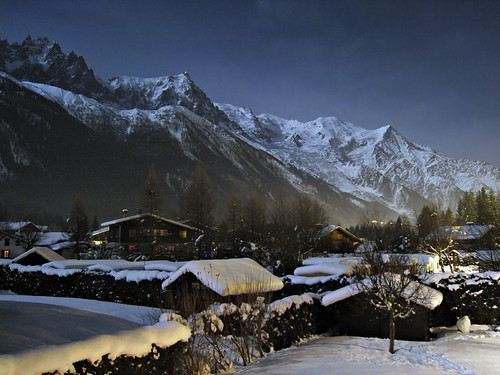
Chamonix, France, hosted the very first Winter Olympic Games ever. This small town in a valley beside Mont Blanc, and a bunch of other mountains, (and I mean a bunch – the valley is surrounded), was “discovered” by modern tourists in 1741 when a pair of Englishmen showed up there and published their account of the incredible glaciers they found. However, they were far from the first people to visit the valley. They weren’t even the first to write about it.
Sometime around the year 1090, a Benedictine convent was founded in the Chamouny valley, and in the documents that granted the land for the convent can be found some clues to the origins of the name of the valley. The words used to describe the valley are campus munitus which translate, roughly, to “fortified field.” Since it was incredibly hard to access the valley at the time, (remember the mountains it’s surrounded by? they’re some of the highest in Europe), it appears that the mountains are the fortification, and the valley is the field. A community, albiet a small one, grew in the valley, so when those two Englishmen arrived in 1741 they met people, not just rivers of ice.
There is a second possibility of the origin of the name Chamonix. Placenames of the World says that the name “derives from a pre-Celtic, possibly Ligurian root, kam, meaning “rounded height.” I think that the fortified field may make more sense, but that’s just my opinion. Anyone is free to send me their arguments for the pre-Celtic root. Maybe we can discover history!
I don’t know exactly the city of Chamonix was founded, (the town created around 1090 was called Le Prieuré), but it seems like a fairly direct line from Chamouny to Chamonix. Maybe it’s even a difference between how a valley should be named and how a city should be named that I’m not aware of.
If you’re interested historical maps, here’s a good one of the area from 1881. Also, the origins of the word Chamonouy were quite difficult to find. It’s on Page 407 of the 1811 edition of A Handbook for travellers in Switzerland and hte Alps of Savoy and Piedmont.

You might be surprised- but right on the other side of the Alps- in Slovenia, is a small town- named Kamnik. Kamen means stone is several slavic languages. Before you enter Chamonix you pass along massive pile of stones that were pushed down the slopes of Mont Blanc by glacier. Hence it is very very unlikely that Chamonix / Kamnik originally meant something else than quarry. Missing link to this theory is similarity of words chamois (french, english) / kamzik (slovak).
Chamonix-Kamenik .3000 years the name is changed but the real meaning come from stone-kamen.
kamy, kamen,(rus, cz, ) kamien(pl), akmen(bls), akmuo(lith), akmens(latv) and all the slavic variations come from the Greek word ΑΚΜΩΝ (άκμων) with transposition of a with k.
akmon means meteoric stone, thunderbolt and later means anvil.
Chamonix is located in the Graian Alps. Graian means Greek.
Cretans were famous archers in the antiquity and came to Marseillaise and the neighboring Greek cities for helping protecting the exploit of woods and other minerals from the Alps. Eventually they settled in the Alps in the area called Graian Alps,( Alpes grees)
I hope you find this information helpful for your search.
We named our daughter Chamonix after the beautiful word (and visiting the beautiful village). Prior to naming her Chamonix, I did a search to confirm if it had meaning. Much like your description, I found text in an old, online record that described “the origin of Chamonix is founded in two latin words: campus munitus meaning ‘the fortified field’ or ‘as sheltered by the mountains’. To arrive at the literal word campus munitus must first be translated into French, campus translated to champ and munitus translated to muni arriving at Chamouni or Chamonix.”
I am rewriting the original posting as follows:
Chamonix
In part: http://fascinatingnames.com/2010/03/chamonix/
Chamonix /shă-mo-NEE/, border of eastern France: Sometime around the year 1090, a Benedictine convent was founded in the Chamouny valley, and in the documents that granted the land for the convent some clues to the origins of the name of the valley can be found. The words used to describe the valley are campus mūnītus, which translate, roughly, to ‘fortified field’. Since it was extremely hard to access the valley at the time, it appears that the mountains are the fortification and the valley is the field. There is a second possibility of the origin of the name Chamonix. Placenames of the World says that the name “derives from a pre-Celtic, possibly Ligurian root, kam, meaning ‘rounded height’. But Sturmfels and Bischof 1961 provide a third possibility: Chamounix = Latin Capimontium = mill field (patois: montium = Latin mŏla, mŏlentium [molendīnum]; molinārius, better molendīnārius = miller) (as well as the campus munitus, as above).